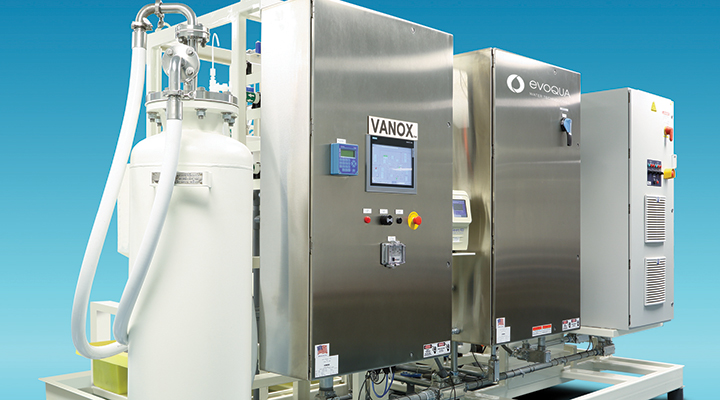Vanox + Carbon or Resin
See All Short Term Operating ContractMobile and emergency solutions for removing 1,4-Dioxane and other contaminants from groundwater.
- is the minimum order quantity for this product. Please check quantity and add to cart again.

Mobile and emergency solutions for removing 1,4-Dioxane and other contaminants from groundwater.
Description
Mobile and emergency solutions for removing 1,4-Dioxane and other contaminants from drinking and other water sources.
1,4-Dioxane (or just “dioxane”) is a colorless, flammable liquid often used in manufacturing chemicals, paper, textiles, cosmetics, and other products. The U.S. Environmental Protection Agency currently identifies dioxane as “likely to be carcinogenic to humans.”
Dioxane is highly mobile in soil, resists microbial degradation, and does not easily volatilize from water. Because it dissolves so readily in water, dioxane migrates rapidly in groundwater. These characteristics make dioxane difficult to remove from groundwater by common water treatment practices such as air stripping and carbon adsorption.
Pump-and-treat remediation can control dissolved 1,4-dioxane groundwater plume migration. The extracted groundwater must have the dioxane removed or destroyed before the treated water can be discharged.
Resin Adsorption
Evoqua’s engineers have found Ambersorb® adsorbant to be an effective synthetic resin for adsorbing 1,4-dioxane and other organic compounds from water. At a low 1,4-dioxane concentration, the resin can last for a reasonable period of time, rendering disposal of the resin after one-time use to be cost effective. At a high 1,4-dioxane concentration, regeneration and reuse of the resin may be more cost effective. Ambersorb adsorbant can be regenerated through steam heating and condensation of the extracted 1,4-dioxane. The condensate then requires disposal. This regeneration may occur in the vessel or after the resin is removed from the media vessel.
Advantages
- Low operating cost, no electricity usage
- Reusable after regeneration
- Not affected by minor influent stream changes
- No air emissions
- Modular – easily sized to application
- Ease of operation and relatively low-maintenance
1,4-Dioxane Treatment Destruction Processes
In general, two types of advanced oxidation technologies are very effective at destroying 1,4-dioxane. One is ultraviolet light (UV) with hydrogen peroxide and the other is ozone with hydrogen peroxide (H2O2). These processes are completed when the UV light or ozone catalyzes the dissociation of H2O2 into OH* radicals, thereby undergoing chain reactions to destroy 1,4-dioxane.
UV/Peroxide
Ultraviolet (UV) light reacts with hydrogen peroxide (H2O2) to form hydroxyl radicals (OH*), a powerful chemical oxidant. The hydroxyl radicals then attack the 1,4-dioxane molecules in solution. UV light-catalyzed peroxide (UV-Ox) is often selected as the treatment method to destroy organics and related compounds in pump-and-treat containment systems when those compounds cannot be effectively treated either by air stripping or by carbon adsorption. The process requires clear water to prevent scattering of the UV light which, in many systems, requires acidification or other pretreatment of the water. Post treatment neutralization may be needed prior to effluent discharge.
Advantages:
- Operates as a destruction process, as opposed to air stripping or carbon adsorption, by which contaminants are extracted and/or concentrated, in a separate phase
- Fast reaction rate
- No transfer of gaseous chemicals into water is required
- No air emissions, and no secondary waste stream or sludge
- Small footprint requirements compared with other technologies
- Modular – easily sized to application
- Standard design for compatibility with commercial electrical cabinets and plumbing
- Waste heat can be utilized for other purposes, such as heating a building
Ozone/Peroxide
Ozone is a powerful oxidant that can degrade organics via both direct and indirect mechanisms. The former is the direct reaction of molecular ozone with the organics. The indirect mechanism involves the secondary oxidants, primarily hydroxyl radicals, which are produced when ozone is degraded. The two major effects of mixing ozone with hydrogen peroxide are: (1) the oxidation efficiency is increased by conversion of ozone molecules to hydroxyl radicals; and (2) ozone transfer from the gas phase to liquid is improved due to an increase in ozone reaction rates.
Advantages:
- Fast reaction rate
- On-site destruction of 1,4-Dioxane without the generation of residues
- Ozone is generated on site
- Suitable for use in residential or commercial settings
Our Approach to 1,4-Dioxane Treatment
At Evoqua, we do not take a “one size fits all approach.” We employ advanced methods to create a precise distribution of oxidants to maximize reaction efficiency. This results in more predictable 1,4-dioxane destruction costs often lower than our competitors. Evoqua engineers will evaluate technologies and will select a reliable treatment option best suited to treat 1,4-dioxane. The selection will be based on the most effective remedy (resin adsorption, UV/peroxide, or ozone/peroxide) with lowest operation and maintenance costs and most feasible to match with the influent water receiving from the other treatment units in operations at the site. Our oxidation system will be designed to meet specific site conditions.
Contact us for more information and to discuss your project!
Features
Types of Remediation
1,4-Dioxane Groundwater Remediation Systems
